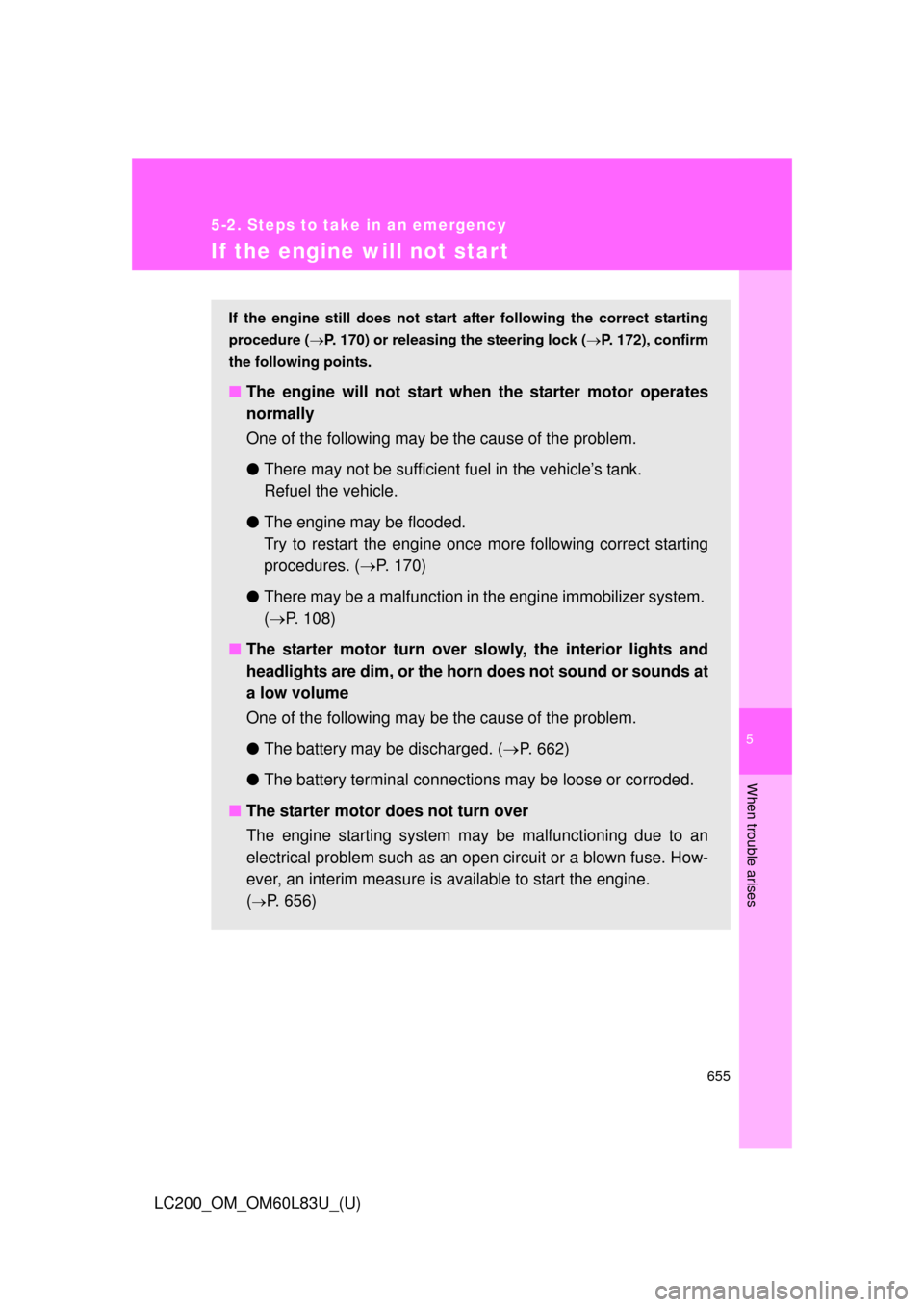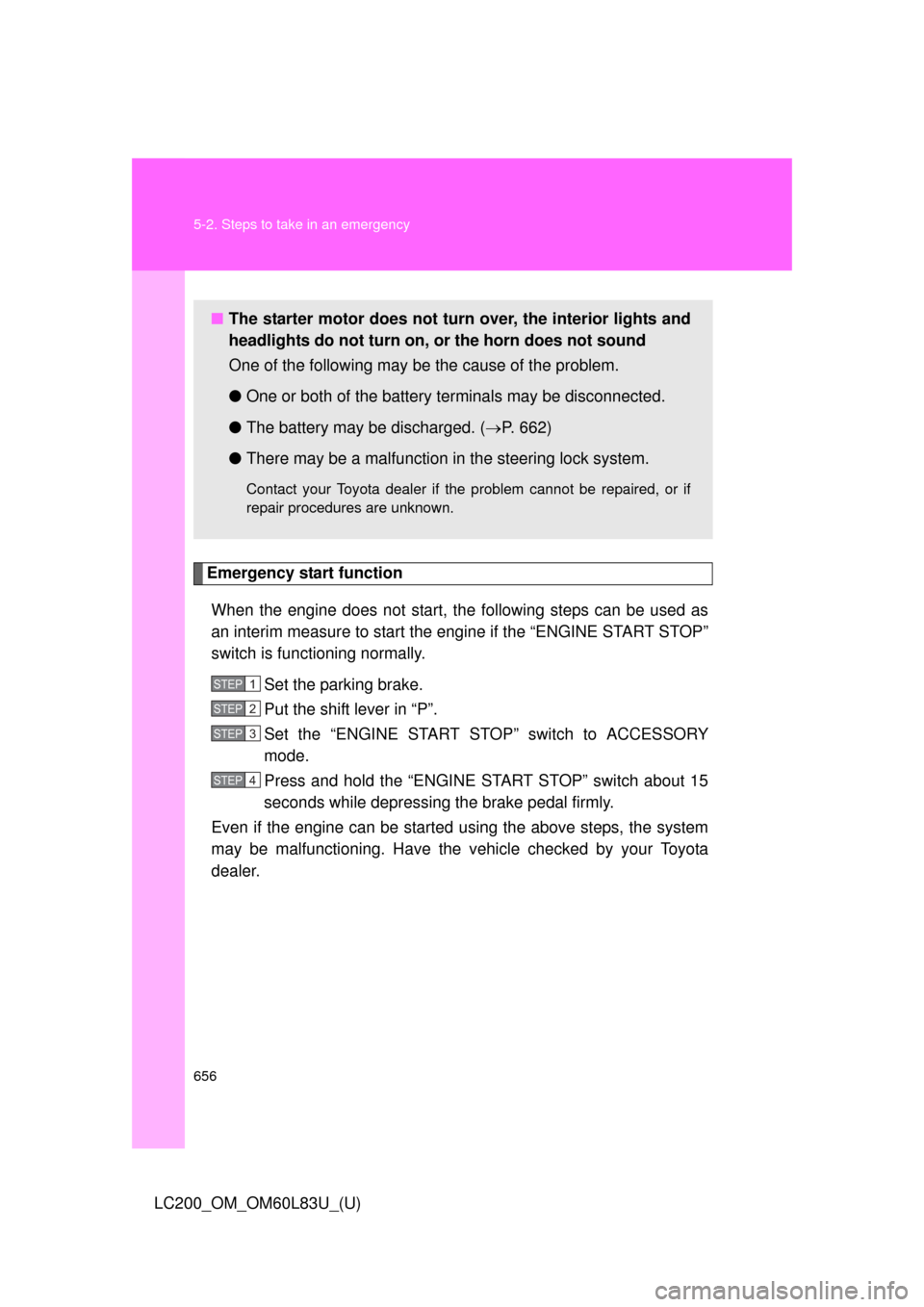Page 622 of 728

622 5-2. Steps to take in an emergency
LC200_OM_OM60L83U_(U)
■If the tire pressure warning light frequently comes on after blinking
for 1 minute
If the tire pressure warning light frequently comes on after blinking for 1
minute when the “ENGINE START STOP ” switch is turned to IGNITION
ON mode, have it checked by Toyota dealer.
CAUTION
■If the tire pressure warning light comes on
Be sure to observe the following precautions. Failure to do so could
cause loss of vehicle control and re sult in death or serious injury.
●Stop your vehicle in a safe place as soon as possible. Adjust the tire
inflation pressure immediately.
●If the tire pressure warning light comes on even after tire inflation pres-
sure adjustment, it is pr obable that you have a flat tire. Check the tires.
If the tire is flat, change to the spare tire and have the flat tire repaired
by the nearest Toyota dealer.
●Avoid abrupt maneuvering and braking. If the vehicle tires deteriorate,
you could lose control of the steering wheel or the brakes.
■If a blowout or sudden air leakage should occur
The tire pressure warning syste m may not activate immediately.
Page 626 of 728
626 5-2. Steps to take in an emergency
LC200_OM_OM60L83U_(U)
Have the vehicle inspected immediately.Failure to investigate the cause of the following warnings may lead to
the system operating abnormally and possibly cause an accident.
Have the vehicle inspected by your Toyota dealer immediately.
Warning messageDetails
Indicates a malfunction in the automatic
transmission system A buzzer also sounds.
Indicates a malfunction in the steering lock
system A buzzer also sounds.
(If equipped) Indicates a malfunction in the pre-collision sys-
tem
A buzzer also sounds.
Page 638 of 728
638 5-2. Steps to take in an emergency
LC200_OM_OM60L83U_(U)
Once(Flashes) A door was
opened and closed
with the “ENGINE
START STOP”
switch turned off
and then the
“ENGINE START
STOP” switch was
put in ACCES-
SORY mode twice
without the engine
being started. Press the
“ENGINE
START
STOP”
switch
while
depressing
the brake
pedal.
Once
(Flashes) The steering lock
could not be
released within 3
seconds of the
“ENGINE START
STOP” switch
being pressed. Press the
“ENGINE
START
STOP”
switch
while
depressing
the brake
pedal and
moving the
steering
wheel left
and right.
Interior
buzzerExterior buzzerWarning messageDetailsCorrection procedure
Page 655 of 728

5
When trouble arises
655
5-2. Steps to take in an emergency
LC200_OM_OM60L83U_(U)
If the engine will not star t
If the engine still does not start after following the correct starting
procedure ( P. 170) or releasing the steering lock (P. 172), confirm
the following points.
■ The engine will not start when the starter motor operates
normally
One of the following may be the cause of the problem.
●There may not be sufficient fuel in the vehicle’s tank.
Refuel the vehicle.
● The engine may be flooded.
Try to restart the engine once more following correct starting
procedures. ( P. 170)
● There may be a malfunction in the engine immobilizer system.
( P. 108)
■ The starter motor turn over slowly, the interior lights and
headlights are dim, or the horn does not sound or sounds at
a low volume
One of the following may be the cause of the problem.
●The battery may be discharged. ( P. 662)
● The battery terminal connec tions may be loose or corroded.
■ The starter motor does not turn over
The engine starting system may be malfunctioning due to an
electrical problem such as an open circuit or a blown fuse. How-
ever, an interim measure is available to start the engine.
(
P. 656)
Page 656 of 728

656 5-2. Steps to take in an emergency
LC200_OM_OM60L83U_(U)
Emergency start functionWhen the engine does not start, the following steps can be used as
an interim measure to start the engine if the “ENGINE START STOP”
switch is functioning normally. Set the parking brake.
Put the shift lever in “P”.
Set the “ENGINE START ST OP” switch to ACCESSORY
mode.
Press and hold the “ENGINE START STOP” switch about 15
seconds while depressing the brake pedal firmly.
Even if the engine can be start ed using the above steps, the system
may be malfunctioning. Have the vehicle checked by your Toyota
dealer.
■ The starter motor does not turn over, the interior lights and
headlights do not turn on, or the horn does not sound
One of the following may be the cause of the problem.
● One or both of the battery terminals may be disconnected.
● The battery may be discharged. ( P. 662)
● There may be a malfunction in the steering lock system.
Contact your Toyota dealer if the problem cannot be repaired, or if
repair procedures are unknown.
STEP1
STEP2
STEP3
STEP4
Page 671 of 728
5
When trouble arises
671
5-2. Steps to take in an emergency
LC200_OM_OM60L83U_(U)
CAUTION
■
If the engine has to be turned off while driving
Power assist for the brakes and steering wheel will be lost, making the brake
pedal harder to depress and the steering wheel heavier to turn. Decelerate
as much as possible before turning off the engine.
Page 682 of 728
682 6-1. Specifications
LC200_OM_OM60L83U_(U)
Steering
Tires and wheels
Free playLess than 1.18 in. (30 mm)
Power steering fluid typeAutomatic transmission fluid DEXRON® II
or III
Tire sizeP285/60R18 114V
Tire inflation pressure
(Recommended cold tire
inflation pressure)
Front tires:
33 psi (230 kPa, 2.3 kgf/cm2 or bar)
Rear tires:
33 psi (230 kPa, 2.3 kgf/cm
2 or bar)
Spare tire:
33 psi (230 kPa, 2.3 kgf/cm
2 or bar)
Wheel size18 8 J
Wheel nut torque97 ft•lbf (131 N•m, 13.4 kgf•m)
Page 693 of 728

693
6-1. Specifications
6
Vehicle specifications
LC200_OM_OM60L83U_(U)
Warning: The temperature grades of a tire assume that it is properly
inflated and not overloaded.
Excessive speed, underinflation, or
excessive loading, either sepa-
rately or in combination, can caus e heat buildup and possible tire fail-
ure.
Glossary of tire terminology
Tire related termMeaning
Cold tire inflation
pressure Tire pressure when the vehicle has been
parked for three hours or more, or has not
been driven more than 1 mile or 1.5 km under
that condition
Maximum inflation
pressure The maximum cold inflated
pressure to which a
tire may be inflated, s hown on the sidewall of
the tire
Recommended
inflation pressure Cold tire inflation pressure recommended by a
manufacturer.
Accessory weight The combined weight (in excess of those stan-
dard items which may be replaced) of trans-
mission, power steering, power brakes, power
windows, power seats, radio and heater, to the
extent that these items
are available as factory-
installed equipment (whether installed or not)
Curb weight The weight of a motor vehicle with standard
equipment, including the maximum capacity of
fuel, oil and coolant, and if so equipped, air
conditioning and additional weight optional
engine
Maximum loaded
vehicle weight The sum of:
(a) Curb weight
(b) Accessory weight
(c) Vehicle capacity weight
(d) Production options weight